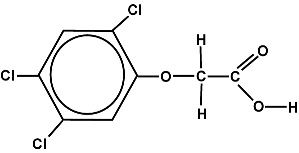Related compounds Molar mass 255.48 g/mol Classification Auxin | Formula C8H5Cl3O3 Density 1.8 g/cm³ | |
 | ||
Appearance Off-white to yellow crystalline solid | ||
Medical vocabulary what does 2 4 5 trichlorophenoxyacetic acid mean
2,4,5-Trichlorophenoxyacetic acid (also known as 2,4,5-T), a synthetic auxin, is a chlorophenoxy acetic acid herbicide used to defoliate broad-leafed plants. It was developed in the late 1940s and was widely used in the agricultural industry until being phased out, starting in the late 1970s due to toxicity concerns. Agent Orange, a defoliant used by the British in the Malayan Emergency and the U.S. in the Vietnam War, was equal parts 2,4,5-T and 2,4-D (2,4-dichlorophenoxyacetic acid). 2,4,5-T itself is toxic with a NOAEL of 3 mg/kg/day and a LOAEL of 10 mg/kg/day. Additionally, the manufacturing process for 2,4,5-T contaminates this chemical with trace amounts of 2,3,7,8-tetrachlorodibenzo-p-dioxin (TCDD). TCDD is a carcinogenic persistent organic pollutant with long-term effects on the environment. With proper temperature control during production of 2,4,5-T, TCDD levels can be held to about .005 ppm. Before the TCDD risk was well-understood, early production facilities lacked proper temperature controls and individual batches tested later were found to have as much as 60 ppm of TCDD.

In 1970, the United States Department of Agriculture halted the use of 2,4,5-T on all food crops except rice, and in 1985, the EPA terminated all remaining uses in the U.S. of this herbicide. The international trade of 2,4,5-T is restricted by the Rotterdam Convention. 2,4,5-T has since largely been replaced by dicamba and triclopyr.

Human health effects from 2,4,5-T at low environmental doses or at biomonitored levels from low environmental exposures are unknown. Intentional overdoses and unintentional high dose occupational exposures to chlorophenoxy acid herbicides have resulted in weakness, headache, dizziness, nausea, abdominal pain, myotonia, hypotension, renal and hepatic injury, and delayed neuropathy.. Cometabolism of 2,4,5-T is possible to produce 3,5-dichlorocatechol which, in turn, can be degraded by Pseudomona bacteria. IARC considers the chlorophenoxyacetic acids group of chemicals as possibly carcinogenic to humans.


